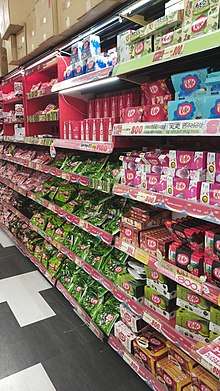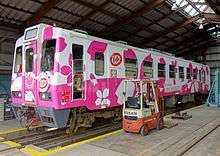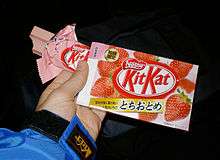Kit Kats in Japan
There have been more than 300 limited-edition seasonal and regional flavors of Kit Kat chocolate bars produced in Japan since 2000.[1][2] Nestlé, which operates the Kit Kat brand in Japan, reports that the brand overtook Meiji Chocolate as the top-selling confection in Japan from 2012 to 2014.[3] The company's marketing campaign, which partnered with Japan Post to sell the bar in 20,000 post offices, won an award in 2010.[4] The campaign encouraged associations of the product's name with the coincidental cognate Kitto Katsu (きっと勝つ), translated as "You will surely win",[5] and could be mailed as a good luck charm for students ahead of university exams.[2]

History
.jpg)
Kit Kats were introduced to Japan in 1973 when Rowntree's made an agreement with Fujiya.[2] In 2014, they were the top-selling confection in the country.[4] The Kit Kat brand took the number one sales position from Meiji chocolate in 2012, though Meiji remains the leading confection company in Japan overall.[3]
In 2004, the green tea flavor was introduced.[6] Since then, the product has been sold in more than 300 seasonal and regional flavors.[1][2] The top-selling flavor of the candy bar in 2010 was soy sauce.[4] Nestlé attributes the success of the flavor varieties to the tradition of omiyage, in which regional specialties are brought back for family and co-workers from trips away.[7] The company believes the limited-edition seasonal models create a "scarcity and rarity of value" for customers.[8]
The business model was created to solve a problem the company found in Japanese convenience stores, which frequently rotated items and flavors off of shelves. By producing smaller runs of flavors, the company was better able to control its production costs.[8] It was also economically viable in Japan because there is no initial product fee for listing new products in Japanese convenience stores.[8]
Kit Kats in Japan are produced at Nestlé-owned factories in Himeji and Kasumigaura. The milk chocolate used for Kit Kats is made from whole-milk powder and Nestlé buys most of its cacao beans from West Africa.[9]
Marketing

Marketing for Kit Kats in Japan is believed to have benefited from the coincidental false cognate with "Kitto Katsu", a phrase meaning "You will surely win" in Japanese.[2] Some market research has shown that the brand is strongly correlated to good luck charms, particularly among students ahead of exams.[2][10][11] Kit Kat's "Lucky Charm" advertising campaign in Japan won the Asian Brand Marketing Effectiveness Award in 2005.[12]
Nestlé and the Japan Post launched a campaign in 2009, allowing people to write messages and mail the chocolate bars from 20,000 post offices.[2] The special packages included a space to write a message of encouragement and affix a stamp. The promotional packages were sold out within a month.[13] That campaign won the Media Grand Prix in 2010's Cannes Lions International Advertising Festival.[4]
Varieties

The Kit Kat Chocolatory, with recipes designed by chef Yasumasa Takagi, opened in 2014, and had expanded to seven branches by 2015. The company claims it has served more than 1 million customers and earned more than 2 billion yen.[2] These shops sell high-end Kit Kat products such as raspberry-infused dark chocolate, orange-chocolate rum, and sakura green tea.[2] A variety of Takagi's flavors have been introduced as seasonal products, including flavors such as "plum, passion fruit and chilli, ginger and kinako soybean powder".[2] In 2016, Nestlé introduced a sake Kit Kat, which combines sake powder with white chocolate.[14]
Some varieties are restricted to a specific region associated with that particular bar.[4] Others are limited-run varieties, with excess supply saved for year-end "happy bag" specials.[4] In 2015, 500 single-finger bitter chocolate bars were sold with gold leaf wrapping for about $16 in high-end retail shops.[7]
Notable varieties include adzuki (red bean),[2][15] beni imo (purple sweet potato),[2][15] brown sugar syrup,[2][15] matcha (green tea),[2][16] and soy sauce.[16][17]
The cafe shop Pronto has introduced croissants incorporating Kit Kats.[2] Pizza chains Napoli no Kama and Strawberry Cones introduced dessert pizzas with bakeable Kit Kat toppings in March 2014.
In October 2018, Nestle opened a Kit Kat store at Namba Station in Osaka.[5]
Additional varieties
- Apple[15]
- Adzuki[2][15]
- Amazake[18]
- Bakeable custard[19]
- Baked potato[2]
- Banana[16][17]
- Beni imo[2]
- Blueberry cheesecake[2][15]
- Brown sugar syrup[2][15]
- Butter[20]
- Cafe au lait[17]
- Cantaloupe[17]
- Cappuccino[2]
- Caramel macchiato McFlurry[15]
- Cherry[4]
- Chestnut[15]
- Chocobanana[2]
- Cinnamon cookie[2]
- Citrus golden blend[2]
- Corn[17]
- Cough Drop[21]
- Creme brulee[17]
- Double cookie[19]
- Edamame[2]
- European cheese[22]
- Exotic Tokyo[16]
- Fruit parfait[2]
- Ginger ale[17]
- Golden citrus[17]
- Green bean[4]
- Hōjicha[2]
- Hokkaido cheese and chocolate[1]
- Hokkaido Melon with Mascarpone Cheese[23]
- Hokkaido roasted corn[1]
- Hot Japanese chili[2]
- Kinako[17]
- Kobe pudding[7]
- Koucha[16]
- Kuchidoke Kakao[19]
- Lemon cheesecake[24]
- Maple[19]
- Matcha[2][16]
- Melon and Cheese[25]
- Miso soup[8]
- Muscat of Alexandria[15]
- Okinawa sweet potato[7]
- Oreo Ice Cream
- Passion fruit[24]
- Pear[2]
- Pumpkin
- Ramune[19]
- Raspberry passionfruit[19]
- Red potato[4]
- Rilakkuma hotcake[22]
- Rock salt[15]
- Royal Milk Tea[26]
- Ruby Chocolate[27]
- Sake[14]
- Sakura[16]
- Sakura matcha latte[22]
- Sakura mochi
- Salt and caramel[15]
- Shikuwasa[28]
- Shinshu apple[2]
- Soy flour[16]
- Soy sauce[16][17]
- Strawberry[2][16]
- Strawberry cheesecake[15][17][22]
- Sweet pudding[15]
- Tokyo Banana[29]
- Triple berry swirl[15]
- Vegetable juice[19]
- Wasabi[1]
- Watermelon[15]
- Yokohama cheesecake[7]
- Yubari melon[4]
- Yuzu[4]
References
- Irvine, Dean (2 February 2012). "How did Kit Kat become king of candy in Japan?". Eatocracy at CNN. CNN. Archived from the original on 8 February 2016. Retrieved 10 February 2016.
- Demetriou, Danielle (12 December 2015). "How the KitKat became a phenomenon in Japan". Telegraph.co.uk. Archived from the original on 14 December 2015. Retrieved 10 February 2016.
- Nieburg, Oliver. "Nestle claims chocolate top spot over Meiji in Japan". Confectionerynews.com. Retrieved 10 February 2016.
- Madden, Normandy. "Soy Sauce flavored Kit Kats? In Japan, they're number one". Ad Age. Archived from the original on 14 January 2016. Retrieved 10 February 2016. – via EBSCO's Academic Search Complete (subscription required)
- "Made-to-order KitKat store opens in Japan". CNN Travel. 2018-11-02. Retrieved 2018-11-12.
- Iyengar, Rishi (26 July 2017). "Nestlé is building a factory just for flavored KitKats". CNN. Retrieved 26 July 2017.
- "Nestle Japan strikes gold Kit Kat in single fingered salute to itself". Guardian. Archived from the original on 20 January 2016. Retrieved 10 February 2016.
- Madden, Normandy (14 June 2010). "Break me off a piece of that soy-sauce bar" (24). Advertising Age. Retrieved 10 February 2016. – via EBSCO's Academic Search Complete (subscription required)
- Rao, Tejal (October 24, 2018), "Big in Japan: the story of how Kit Kats became a booming business from Hokkaido to Tokyo and changed expectations about what a candy bar could be.", The New York Times
- Vaidyanathan, Rajiv; Aggarwal, Praveen (2008). "A Typology of Superstitious Behaviors: Implications for Marketing and Public Policy". Advances in Consumer Research – Latin American Conference Proceedings. 2: 147–149. Retrieved 10 February 2016 – via EBSCO's Academic Search Complete (subscription required)
- Ryall, Julien (2 February 2005). "Exam fever gives Japan a craving for Kit Kat". The Telegraph. Archived from the original on 7 January 2016. Retrieved 10 February 2016.
- "Media: Asia's Media & Marketing Newspaper". Media: Asia's Media & Marketing Newspaper. Haymarket Business Publications Ltd: 39. 15 July 2005. ISSN 1562-1138. Retrieved 10 February 2016 – via EBSCO's Academic Search Complete (subscription required)
- Saven, Mandy (1 October 2010). "Hitting close to home: how a local identity enhances the packaging solution". Brand Packaging. BNP Media. Archived from the original on 4 May 2016. Retrieved February 10, 2016 – via HighBeam Research.
- McGee, Oona. "Sake-flavored KitKat". Japan Today. Japan Today. Retrieved 15 March 2016.
- "Japanese KitKats II". www.avclub.com. Retrieved 2016-03-13.
- "Taste Test: Japanese KitKats". www.avclub.com. Retrieved 2016-03-13.
- Neary, Lynn (14 May 2010). "Kit Kat Kaleidoscope: Far-Out Flavors From Japan". NPR news. National Public Radio. Retrieved 10 February 2016.
- "Kit Kat Mini Amazake Flavor – White Rabbit Japan". whiterabbitjapan.com. Retrieved 2018-05-25.
- Harris, Jenn (14 March 2014). "Japan to get new Kit Kats you can heat, and we want them". Los Angeles Times. Archived from the original on 17 September 2014. Retrieved 10 February 2016.
- "Butter-flavored Kit Kats come to Japan as new specialty store opens in Hokkaido". www.soranews24.com. Retrieved 2018-05-13.
- McGee, Oona (22 August 2017). "Now you can buy cough-drop flavoured Kit Kats in Japan". SoraNews24. Rocket News. Retrieved 22 August 2017.
- Modell, Josh (26 March 2012). "Kit Kat: European Cheese, Rilakkuma Hotcake, Strawberry Cheesecake, and Sakura Maccha Latte". AV Club. AV Club. Archived from the original on 7 September 2015. Retrieved 10 February 2016.
- Kay (27 April 2016). "Special melon and cheese-flavored Kit Kat now available, but only at selected airports!". RocketNews24. Retrieved 22 February 2017.
- "Japan snaps up 'lucky' Kit Kats". BBC. 2005-02-02. Retrieved 2016-03-13.
- "Special melon and cheese-flavored Kit Kat now available, but only at selected airports!". SoraNews24. 2016-04-27. Retrieved 2018-03-09.
- Courtland, Emma. "TOP 10 KIT KAT FLAVORS YOU'VE PROBABLY NEVER TRIED". LA Weekly. LA Weekly. Retrieved 15 March 2016.
- "Nestlé Kit Kat Japan Product". Retrieved 2019-04-14.
- Casey Baseel (10 April 2016). "Okinawan citrus is the latest addition to Kit Kat's awesome only-in-Japan lineup". RocketNews24. Retrieved 22 February 2017.
- Murai, Shusuke (4 January 2018). "Japan-only Kit Kat varieties a draw as tourists spend more". The Japan Times Online. The Japan Times. Retrieved 6 January 2018.
External links
- KIT KAT Japan on Twitter
- KitKat on Facebook